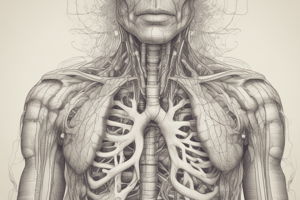Podcast
Questions and Answers
What is the primary function of the bronchioles in the human gas exchange system?
What is the primary function of the bronchioles in the human gas exchange system?
- To warm and humidify the air we breathe
- To produce mucus to trap dust and bacteria
- To branch into smaller airways, increasing the surface area for gas exchange (correct)
- To filter out dust and other particles from the air
Where is ciliated epithelium typically found in the human gas exchange system?
Where is ciliated epithelium typically found in the human gas exchange system?
- In the capillary network, where it facilitates oxygen delivery
- In the trachea and bronchi, where it helps to move mucus upwards (correct)
- In the alveoli, where gas exchange occurs
- In the bronchioles, where it increases the surface area for gas exchange
What is the primary function of the capillary network in the human gas exchange system?
What is the primary function of the capillary network in the human gas exchange system?
- To filter out dust and other particles from the air
- To warm and humidify the air we breathe
- To exchange oxygen and carbon dioxide through the alveoli (correct)
- To produce mucus to trap dust and bacteria
What type of epithelium lines the alveoli?
What type of epithelium lines the alveoli?
Where is cartilage typically found in the human gas exchange system?
Where is cartilage typically found in the human gas exchange system?
Flashcards are hidden until you start studying
Study Notes
Structure of the Human Gas Exchange System
- The gas exchange system consists of lungs, trachea, bronchi, bronchioles, alveoli, and a capillary network
- The trachea bifurcates into two primary bronchi, which then branch into smaller bronchi and bronchioles
- Bronchioles eventually terminate into alveoli, which are responsible for gas exchange
- Alveoli are surrounded by a network of capillaries, allowing for the exchange of oxygen and carbon dioxide
Distribution of Structures in the Gas Exchange System
- Cartilage is present in the trachea and bronchi, providing structural support and maintaining airway patency
- Ciliated epithelium is found in the trachea and bronchi, helping to remove mucus and debris from the airway
- Goblet cells are present in the trachea and bronchi, producing mucus that traps dust and other particles
- Squamous epithelium is found in the alveoli, allowing for gas exchange to occur
- Smooth muscle is present in the bronchioles, controlling airway diameter and regulating airflow
- Capillaries are found surrounding the alveoli, allowing for the exchange of oxygen and carbon dioxide between the air and blood
Studying That Suits You
Use AI to generate personalized quizzes and flashcards to suit your learning preferences.




